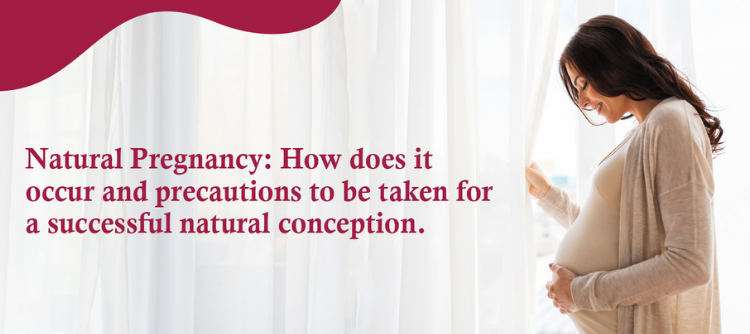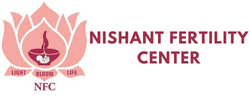Natural Pregnancy: How does it occur and precautions to be taken for a successful natural conception

Most of the newly married couples who try for conception do not succeed because they are not aware of the right way to conceive. As a result, they get stressed and start visiting infertility specialists and gynecologists. Sharing an incident, Dr. Nishant Dixit, renowned Reproductive Medicine Specialist and Infertility Expert told that a couple arrived in the OPD clinic who was married 1-1.5 years ago and they were unable to conceive although the reports were normal. Their primary concern was to know how naturally pregnancy occurs so that they can avoid the common mistakes that are generally made. When explained the correct method, the couple was able to conceive in the next 2 to 3 months.
In the current blog, we will discuss the process of natural pregnancy and the precautions a couple should keep in mind to avoid major mistakes for a naturally conceived pregnancy. It is a known fact that after marriage a couple needs time to understand each other. Further, as most of the couples are working, financial stability and focus on their career is also a key priority for them. A couple starts family planning once all these priorities are managed effectively. But in case, pregnancy is not achieved within 3-5 months, a couple starts consulting a doctor.
Process for a naturally conceived pregnancy
Women with a normal menstruation cycle get periods in 28-30 days. From the starting of the menstruation cycle like day 1, 2 3, an egg begins to enlarge. This enlarged egg is known as a follicle. A follicle is a small fluid-filled sac with a small egg inside. In the middle of the menstruation cycle, such as the 12th, 13th, or 14th day, the size of the follicle is approximately 20mm. After this, the egg ruptures, and the egg inside the follicle (known as oocyte) is released into the abdominal cavity. This process is known as ovulation. The size of the oocyte is approximately 120 micrometers which are not visible through naked eyes and can be seen only through a microscope. Due to the negative pressure of the fimbrial ends of the fallopian tubes in the uterus, the egg comes to tubes from the abdominal cavity. After ovulation, the egg can survive for only 12 to 24 hrs which means it has a fertilization capacity for this much time only. During this time, if the egg meets the sperm, there is a good possibility of achieving pregnancy. On the other hand, if the egg does not meet the sperm during this period, then in the next 14 days, the menstruation cycle starts again and the woman gets her period. In a normal period cycle, couples are advised to stay together alternate days between the 8th to 18th day. This is because the sperms survive within the female body for a period of 48 to 72 hrs. If ovulation occurs during this period, then there are maximum chances of pregnancy.
What do you need to check for a successful natural pregnancy?
- The report of semen analysis for a male partner should be in the normal range.
- The quantity, motility, morphology of sperms should be normal.
- DNA Fragmentation should be normal for a healthy pregnancy.
- In a female partner, at least one of the fallopian tubes out of the two should be healthy because it is the place where the eggs and the sperm meet to form an embryo. In the case of a blocked fallopian tube, fertilization is not possible and thus, natural pregnancy cannot take place.
- Timely ovulation is also necessary for females. When periods are regular, ovulation also takes place on time. In case of irregular periods, certain hormonal tests are required to be done to find out the cause of irregularity.
In short
As pregnancy is one of the most beautiful phases of a woman’s life, before initiating family planning, it is required that both the partners should understand each other well and plan accordingly. In case the couple is unable to conceive naturally although all reports are normal, they can consult an infertility specialist for a more detailed evaluation of the condition and find the real cause for not having pregnancy naturally.
प्राकृतिक गर्भावस्था: यह कैसे होती है और सफल प्राकृतिक गर्भाधान के लिए बरती जाने वाली सावधानियां
गर्भधारण की कोशिश करने वाले अधिकांश नवविवाहित जोड़े सफल नहीं होते हैं क्योंकि उन्हें गर्भ धारण करने के सही तरीके के बारे में पता नहीं होता है। नतीजतन, वे तनावग्रस्त हो जाते हैं और इनफर्टिलिटी विशेषज्ञों और स्त्री रोग विशेषज्ञों के पास जाने लगते हैं। एक घटना को साझा करते हुए, प्रसिद्ध प्रजनन चिकित्सा विशेषज्ञ और इनफर्टिलिटी विशेषज्ञ डॉ निशांत दीक्षित ने बताया कि ओपीडी क्लिनिक में एक दम्पति आया था जिसकी शादी 1- 1.5 साल पहले हुई थी और रिपोर्ट सामान्य होने के बावजूद वे गर्भ धारण करने में असमर्थ थे। उनकी प्राथमिक चिंता यह जानना थी कि प्राकृतिक रूप से गर्भावस्था कैसे होती है ताकि वे आम तौर पर की जाने वाली सामान्य गलतियों से बच सकें। जब सही तरीका समझाया गया, तो दंपति अगले 2 से 3 महीनों में गर्भधारण करने में सक्षम हो गए।
वर्तमान ब्लॉग में हम प्राकृतिक गर्भावस्था की प्रक्रिया और उन सावधानियों पर चर्चा करेंगे जो एक दम्पति को ध्यान में रखनी चाहिए प्राकृतिक रूप से गर्भ धारण करने के लिए। यह एक सर्वविदित तथ्य है कि शादी के बाद एक दम्पति को एक दूसरे को समझने के लिए समय चाहिए होता है। इसके अलावा, चूंकि अधिकांश दम्पति कामकाजी है, वित्तीय स्थिरता और अपने करियर पर ध्यान देना भी उनके लिए एक प्रमुख प्राथमिकता है। इन सभी प्राथमिकताओं को प्रभावी ढंग से प्रबंधित करने के बाद दम्पति परिवार नियोजन शुरू करता है। लेकिन अगर 3-5 महीने के भीतर गर्भधारण नहीं होता है, तो दंपति डॉक्टर से सलाह लेना शुरू कर देते हैं।
प्राकृतिक रूप से गर्भ धारण करने की प्रक्रिया
सामान्य मासिक धर्म वाली महिलाओं को 28-30 दिनों में पीरियड्स आ जाते हैं। मासिक धर्म चक्र की शुरुआत के पहले, दूसरे, तीसरे दिन से एक अंडा बड़ा होना शुरू हो जाता है। इस बढ़े हुए अंडे को फॉलिकल कहा जाता है। फॉलिकल तरल से भरी एक छोटी थैली होती है जिसके अंदर एक छोटा अंडा होता है। मासिक धर्म चक्र के बीच में, जैसे कि 12वें, 13वें या 14वें दिन, फॉलिकल का आकार लगभग 20 मिमी होता है। इसके बाद, अंडा फट जाता है, और फॉलिकल के अंदर का अंडा (जिसे oocyte कहा जाता है) एब्डोमिनल कैविटी में छोड़ दिया जाता है। इस प्रक्रिया को ओव्यूलेशन के रूप में जाना जाता है। अंडाणु का आकार लगभग 120 माइक्रोमीटर होता है जो नग्न आंखों से दिखाई नहीं देता है और केवल एक माइक्रोस्कोप के माध्यम से देखा जा सकता है।
गर्भाशय में फैलोपियन ट्यूब के फिम्ब्रिएल एंड्स के नकारात्मक दबाव के कारण, अंडा एब्डोमिनल कैविटी से ट्यूबों में आता है। ओव्यूलेशन के बाद, अंडा केवल 12 से 24 घंटे तक जीवित रह सकता है, जिसका अर्थ है कि इसमें केवल इतने समय के लिए निषेचन क्षमता है। इस दौरान अगर अंडाणु शुक्राणु से मिल जाए तो गर्भधारण की अच्छी संभावना होती है। वहीं अगर इस दौरान अंडा शुक्राणु से नहीं मिलता है तो अगले 14 दिनों में मासिक धर्म फिर से शुरू हो जाता है और महिला को मासिक धर्म हो जाता है। एक सामान्य मासिक धर्म चक्र में, दम्पति को 8वें से 18वें दिन के बीच एक दिन छोड़कर साथ रहने की सलाह दी जाती है। ऐसा इसलिए है क्योंकि शुक्राणु महिला शरीर के भीतर 48 से 72 घंटे तक जीवित रहते हैं। यदि इस अवधि के दौरान ओव्यूलेशन होता है, तो गर्भधारण की संभावना सबसे अधिक होती है।
एक सफल प्राकृतिक गर्भावस्था के लिए क्या ज़रूरी है?
- पुरुष की वीर्य विश्लेषण रिपोर्ट सामान्य होनी चाहिए।
- शुक्राणुओं की मात्रा, गतिशीलता, व आकार सामान्य होना चाहिए।
- स्वस्थ गर्भावस्था के लिए DNA Fragmentation सामान्य होना चाहिए।
- महिला में दोनों में से कम से कम एक फैलोपियन ट्यूब स्वस्थ होनी चाहिए क्योंकि यह वह जगह है जहां अंडे और शुक्राणु एक भ्रूण बनाने के लिए मिलते हैं। अवरुद्ध फैलोपियन ट्यूब में निषेचन संभव नहीं है और इसलिए प्राकृतिक गर्भावस्था नहीं हो सकती है।
- महिलाओं के लिए समय पर ओव्यूलेशन भी जरूरी है। जब पीरियड्स नियमित होते हैं तो ओव्यूलेशन भी समय पर होता है। अनियमित माहवारी के कारणों का पता लगाने के लिए कुछ हार्मोनल परीक्षण करने की आवश्यकता होती है।
डॉ निशांत दीक्षित निशांत फर्टिलिटी सेंटर के डायरेक्टर हैं, जो एक बेहद अनुभवी Reproductive Medicine Specialist/ प्रजनन चिकित्सा विशेषज्ञ हैं। डॉ. दीक्षित ने अपनी प्रोफेशनल लाइफ को दम्पतियों के माता-पिता बनने के सपने को साकार करने में मदद करने के लिए समर्पित किया है। उनका मंत्रा “LET’S MAKE YOU A FAMILY” निशांत फर्टिलिटी सेंटर (NFC) की पूरी टीम का मिशन स्टेटमेंट बन गया है। वे चिकित्सा अनुसंधान में सक्रिय रूप से शामिल हैं और उन्हें फैकल्टी के रूप में आमंत्रित किया गया है और उन्होंने कई राष्ट्रीय और अंतर्राष्ट्रीय सम्मेलनों में कई लेक्चर दिए हैं।
- Dr. Nishant Dixit
- DNB (OBGY), MNAMS
- Fellowship in Reproductive Medicine
- Director, Nishant Fertility Centre
- Reproductive Medicine Specialist
